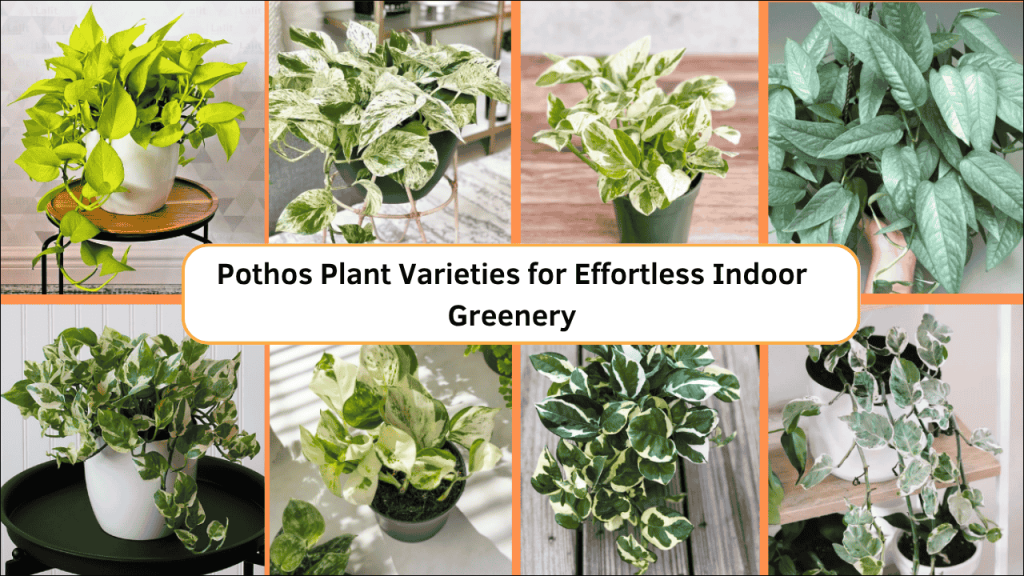
In the world of houseplants, few species can match the perfect combination of beauty, resilience, and versatility that Pothos plants offer. Known affectionately as “devil’s ivy” for their nearly indestructible nature and rapid growth, Pothos plants have become the cornerstone of indoor gardens worldwide. These tropical vines not only add lush greenery to any space but also serve as natural air purifiers, making them both aesthetically pleasing and functionally beneficial for your home environment.
Whether you’re a seasoned plant parent or just beginning your indoor gardening journey, Pothos varieties offer something for everyone. From the classic golden hues that brighten dark corners to striking variegated patterns that serve as living art pieces, these plants adapt to various lighting conditions and forgive occasional neglect. Their trailing vines can cascade elegantly from hanging baskets, climb moss poles, or drape gracefully from shelves, making them incredibly versatile for interior design.
The appeal of Pothos extends beyond their forgiving nature. These plants are known for their air-purifying qualities, helping to remove common household toxins like formaldehyde, xylene, and toluene from indoor spaces. This makes them not just decorative elements but functional additions to creating healthier indoor environments. With their heart-shaped leaves and vigorous growth patterns, Pothos plants can quickly transform any room into a green sanctuary.
The Ultimate Guide to Popular Pothos Varieties
1. Golden Pothos (Epipremnum aureum)
The Golden Pothos stands as the most recognizable and beloved variety among houseplant enthusiasts. Its distinctive heart-shaped leaves feature stunning splashes of golden yellow against rich green backgrounds, creating a warm, inviting appearance that complements virtually any interior design style. This variety earned its reputation as the perfect beginner plant due to its remarkable adaptability to various lighting conditions, from bright indirect light to dimly lit corners.
What makes Golden Pothos particularly special is its vigorous growth habit and trailing capability. The vines can extend several feet in length, making dramatic displays when allowed to cascade from elevated positions. Beyond aesthetics, this variety is renowned for its air-purifying properties, actively removing harmful toxins from indoor air while adding oxygen to your living space.
2. Marble Queen Pothos
The Marble Queen Pothos represents elegance in the plant world with its sophisticated cream and green marbled foliage. Each leaf displays unique patterns of variegation, creating a living work of art that never fails to captivate viewers. While this variety grows more slowly than its solid-green counterparts due to reduced chlorophyll content in the lighter portions, its stunning appearance more than compensates for the patience required.
This variety thrives in bright, indirect light conditions that help maintain its striking variegation patterns. The creamy white sections of the leaves require adequate light to prevent the plant from reverting to solid green, making proper placement crucial for maintaining its decorative appeal.
3. Neon Pothos
For those seeking to add vibrant energy to their indoor spaces, the Neon Pothos delivers with its brilliant chartreuse to lime-green foliage. This variety brings an almost fluorescent quality to rooms, instantly lifting moods and creating focal points that draw attention. The bright coloration makes it particularly effective in modern, minimalist, or bohemian interior designs where bold statements are welcomed.
Despite its striking appearance, Neon Pothos maintains the family’s reputation for easy care. It adapts well to various lighting conditions, though its color intensity may vary depending on light exposure. In lower light settings, the leaves may deepen to a more traditional green, while bright indirect light maintains the vibrant neon quality.
4. Jade Pothos
The Jade Pothos offers timeless beauty with its deep, glossy green leaves that provide a classic, sophisticated appearance. This variety appeals to those who prefer clean, monochromatic plant aesthetics without the complexity of variegated patterns. Its rich green coloration works seamlessly with both light and dark interior color schemes, making it a versatile choice for any room.
As one of the hardiest Pothos varieties, Jade Pothos demonstrates exceptional tolerance for various growing conditions. Its fast growth rate and robust nature make it ideal for filling spaces quickly while requiring minimal maintenance from its caretakers.
5. Cebu Blue Pothos (Epipremnum pinnatum ‘Cebu Blue’)
The Cebu Blue Pothos brings exotic appeal with its unique silvery-blue foliage that shimmers subtly in changing light conditions. Native to the Philippines, this variety offers something distinctly different from traditional green Pothos plants. As the plant matures under optimal conditions, it may develop fenestrations (natural leaf splits) that add even more visual interest.
This variety demonstrates remarkable adaptability to typical indoor conditions while preferring bright, indirect light and higher humidity levels. Its unique coloration and elegant growth pattern make it a prized addition to plant collections, particularly for those seeking unusual and conversation-starting specimens.
6. Manjula Pothos
The Manjula Pothos stands out as a true conversation piece with its broad, heart-shaped leaves featuring stunning variegation in cream, light green, and silver-gray tones. Each leaf displays unique marbled patterns that create an almost hand-painted appearance, ensuring no two leaves are identical. The slightly wavy leaf edges add additional visual texture that distinguishes it from other Pothos varieties.
This variety requires medium to bright indirect light to maintain its striking variegation patterns. The artistic quality of its foliage makes it particularly suitable for modern or contemporary interior designs where plants serve as decorative focal points.
7. Pearls and Jade Pothos
The Pearls and Jade Pothos charms with its delicate, compact appearance featuring small leaves with intricate variegation in white, green, and silver-gray. This cultivar’s refined patterns and manageable size make it perfect for tabletops, desks, and small hanging displays where space is limited but impact is desired.
While slower-growing than many Pothos varieties, Pearls and Jade rewards patience with ornamental foliage that instantly softens and brightens indoor spaces. Its trailing vines create elegant displays that work particularly well in minimalist or sophisticated interior settings.
8. N’Joy Pothos
The N’Joy Pothos captivates with its crisp white and green leaves featuring distinctive patterns reminiscent of artistic brushstrokes. Its compact growth habit makes it ideal for smaller spaces or decorative arrangements on shelves and countertops. The clean, sophisticated appearance of this variety pairs beautifully with other plants or stands alone as an elegant statement piece.
Like other variegated varieties, N’Joy thrives in bright, indirect light but demonstrates tolerance for lower light levels, though variegation may become less pronounced in dimmer conditions.
9. Glacier Pothos
The Glacier Pothos offers understated elegance with its small, heart-shaped leaves featuring cool, silvery-green variegation. The speckled or marbled patterns of white and gray create a frosted appearance that gives this variety its distinctive name. Its compact size and refined beauty make it perfect for smaller spaces or minimalist plant displays.
This variety demonstrates the typical Pothos easygoing nature while providing unique visual appeal that works particularly well in modern or contemporary settings where subtle sophistication is preferred over bold statements.
Comprehensive Pothos Variety Comparison
| Variety | Leaf Color/Pattern | Growth Rate | Light Requirements | Best Placement | Special Features |
|---|---|---|---|---|---|
| Golden Pothos | Green with golden splashes | Fast | Low to bright indirect | Anywhere indoors | Most beginner-friendly, excellent air purifier |
| Marble Queen | Cream and green marbled | Moderate | Bright indirect | Bright rooms, offices | Stunning variegation, sophisticated appearance |
| Neon Pothos | Bright chartreuse/lime | Fast | Medium to bright indirect | Modern spaces | Vibrant color, mood-lifting |
| Jade Pothos | Deep glossy green | Fast | Low to bright indirect | Any room | Classic beauty, very hardy |
| Cebu Blue | Silvery-blue shimmer | Fast | Bright indirect | Plant shelves, hanging | Unique color, develops fenestrations |
| Manjula | Cream, light green, silver-gray | Moderate | Medium to bright indirect | Contemporary spaces | Wavy leaf edges, artistic patterns |
| Pearls and Jade | White, green, silver-gray | Slow | Bright indirect | Desks, small spaces | Compact size, intricate patterns |
| N’Joy | White and green brushstrokes | Moderate | Bright indirect preferred | Shelves, countertops | Crisp patterns, compact growth |
| Glacier | Silvery-green with white/gray | Slow | Moderate to bright indirect | Office desks, small planters | Frosted appearance, refined beauty |
Care Tips for Thriving Pothos Plants
Successful Pothos cultivation relies on understanding their basic needs and providing consistent care. These plants prefer well-draining potting soil that allows excess water to escape while retaining adequate moisture. A standard houseplant potting mix works well, though adding perlite can improve drainage for varieties sensitive to overwatering.
Watering should follow the “soak and dry” method, allowing the top inch of soil to dry between waterings. Overwatering is more problematic than underwatering for Pothos plants, as they prefer slightly dry conditions over consistently moist soil. During winter months, reduce watering frequency as plant growth slows and water requirements decrease.
Humidity levels between 40-60% support healthy growth, though most Pothos varieties tolerate typical household humidity levels. In dry environments, grouping plants together or using humidity trays can provide additional moisture. Regular misting can help but should be done sparingly to avoid fungal issues.
Fertilizing during the growing season (spring and summer) with a balanced, diluted houseplant fertilizer supports vigorous growth and maintains foliage color. Monthly feeding is typically sufficient, with no fertilization needed during winter dormancy periods.
Propagation and Maintenance
Pothos plants are among the easiest houseplants to propagate, making them perfect for sharing with friends or expanding your collection. Stem cuttings with at least one node can be rooted in water or directly planted in soil. Water propagation allows you to watch root development, while soil propagation often results in stronger, more established root systems.
Regular maintenance involves pruning to control size and encourage bushier growth. Pinching growing tips promotes branching, while removing any yellowing or damaged leaves maintains plant health and appearance. Cleaning leaves periodically with a damp cloth helps maintain their glossy appearance and improves photosynthesis efficiency.
Repotting becomes necessary when plants outgrow their containers, typically every 2-3 years for most varieties. Signs that repotting is needed include roots growing through drainage holes, water running straight through the pot, or significantly slowed growth despite proper care.
Creating Stunning Displays with Multiple Varieties
Combining different Pothos varieties creates dynamic, layered displays that showcase the diversity within this plant family. Mixing trailing and upright growth habits, along with contrasting foliage colors and patterns, produces visually interesting arrangements that serve as living art installations.
Consider grouping varieties with similar care requirements but different visual characteristics. For example, combining Golden Pothos with Marble Queen and Neon varieties creates a display with varying heights, colors, and textures while maintaining consistent care routines.
Vertical growing systems, such as moss poles or trellises, allow climbing varieties to express their natural growth habits while conserving floor space. This approach works particularly well with varieties like Cebu Blue that develop more dramatic foliage characteristics when allowed to climb.
Frequently Asked Questions
Q: How often should I water my Pothos plants?
A: Water when the top inch of soil feels dry, typically every 1-2 weeks depending on environmental conditions.
Q: Can Pothos plants survive in low light conditions?
A: Yes, most Pothos varieties tolerate low light, though variegated types may lose their patterns in insufficient light.
Q: Are Pothos plants toxic to pets?
A: Yes, Pothos plants are toxic to cats and dogs if ingested, so keep them out of reach of pets.
Q: How fast do Pothos plants grow?
A: Most varieties are fast-growing, with vines potentially reaching several feet in length within a single growing season.
With their incredible diversity, easy care requirements, and stunning visual appeal, Pothos plants truly deserve their reputation as the ultimate indoor greenery solution. Whether you choose one variety or collect them all, these remarkable plants will transform your living space into a lush, healthy environment that brings joy year-round.














The punchline should be the last possible thing they expect — pluscomedy.com